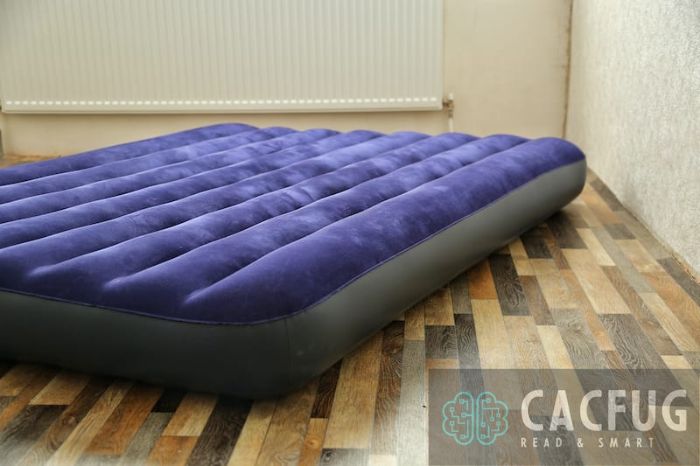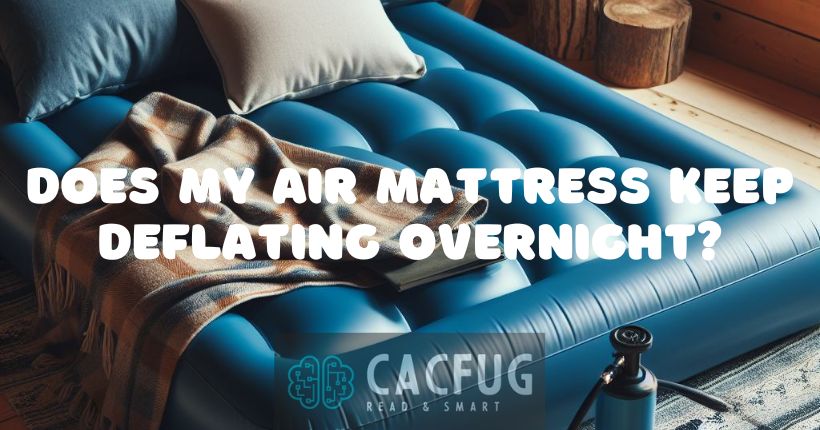Waking up to a deflated air mattress is a frustrating experience many people have faced. Whether it’s for camping trips, accommodating guests, or daily use, air mattresses offer convenience and portability. However, recurring deflation can ruin your sleep and leave you wondering what went wrong.
Understanding the root causes of air leaks is essential for finding the right solution. This article will explain the most common reasons why your air mattress may be deflating overnight and how to fix or prevent these issues.
Temperature Changes and Air Compression
Air mattresses are sensitive to temperature changes, which can significantly affect air pressure. When the temperature drops at night, the air inside the mattress contracts, causing it to deflate slightly. This is a natural process that occurs due to the cooling of the air molecules, which occupy less space in colder environments.
How Cold Environments Affect Air Mattresses:
- In cold weather or air-conditioned rooms, the deflation can become more noticeable as the temperature difference between day and night increases.
- Air mattresses used outdoors during camping trips can also experience rapid deflation due to lower night-time temperatures.
Tips for Managing Temperature Changes:
- Use a mattress topper or thick blanket to insulate the mattress from cold floors or surfaces.
- Keep the room temperature consistent or use a space heater to prevent drastic drops in temperature.
- Avoid placing the mattress directly on cold surfaces like tile or concrete.
Tiny Holes or Punctures

One of the most common reasons for air mattresses deflating overnight is the presence of small, almost invisible holes or punctures. These tiny leaks cause slow air loss that accumulates over time, leaving your mattress deflated by morning.
Common Causes of Tiny Holes:
- Contact with sharp objects like keys, zippers, or pets’ claws.
- Rough surfaces that rub against the mattress material.
- Improper storage, such as folding the mattress near sharp edges.
How to Locate Tiny Holes:
- Inflate the mattress fully.
- Mix soapy water in a spray bottle.
- Spray the mattress surface, especially around seams and valve areas.
- Look for bubbles forming, which indicate the location of the hole.
- Listen for any hissing sounds that may point to air escaping.
Solutions:
- Use an air mattress repair kit to patch holes. These kits typically include adhesive patches that create a long-lasting seal.
- Regularly inspect and store the mattress in a puncture-free environment to prevent future damage.
Poor Valve Seal
The valve is the most crucial component of your air mattress, and a poor seal can result in continuous air leaks. Even a small issue with the valve can cause significant deflation over time.
Signs of a Faulty Valve:
- Air escaping around the valve, even when it’s sealed.
- Difficulty in properly closing or sealing the valve after inflation.
How to Fix Valve Issues:
- Ensure that the valve is fully closed and properly sealed after inflating the mattress.
- If the valve is damaged or no longer sealing correctly, consider replacing it with a new one or use a temporary sealant to fix the leak.
- Many air mattress repair kits also include valve repair components.
Over-Inflation
While it may be tempting to over-inflate your air mattress to achieve maximum firmness, this can actually damage the material. Over-inflating puts stress on the seams and the surface of the mattress, which can cause tiny tears or leaks over time.
The Impact of Over-Inflation:
- Overstretching the mattress material makes it more prone to punctures and seam damage.
- Continuous over-inflation can result in weakened structural integrity, leading to premature deflation.
Correct Inflation Level:
- Inflate the mattress to about 90% of its capacity, leaving room for natural expansion once you lie on it.
- Avoid inflating the mattress to the point where it feels rigid.
Aging and Wear
Just like any other product, air mattresses have a lifespan. Over time, the materials and seams begin to weaken due to regular use, resulting in slow air leaks.
Signs of Wear and Tear:
- Seams starting to separate or weaken.
- Persistent air leaks even after repairs.
- Noticeable thinning of the mattress material.
When to Replace Your Air Mattress:
- If your mattress is over 3-5 years old and regularly deflates overnight, it may be time to invest in a new one.
- Multiple repairs and patches can indicate that the mattress has reached the end of its lifespan.
Improper Usage and Setup

Improper setup or usage can cause slow deflation in air mattresses. The surface on which the mattress is placed, along with weight distribution, plays a role in how well it holds air.
Common Setup Mistakes:
- Placing the mattress on rough or uneven surfaces that could create small tears.
- Exceeding the recommended weight limit of the mattress.
- Using the mattress for purposes it wasn’t designed for, such as prolonged outdoor use.
Tips for Proper Setup:
- Choose smooth, clean surfaces to set up your air mattress.
- Use a protective pad or mattress cover to add an extra layer of defense against sharp objects or uneven ground.
- Ensure the mattress is set up in a spacious area, avoiding any close proximity to objects that might cause punctures.
Environmental Factors
Environmental factors, including humidity, moisture, and altitude, can also influence the air pressure inside the mattress.
Effects of Environment on Air Mattresses:
- High humidity levels can weaken the material, causing air to seep out over time.
- Altitude changes, especially when camping, can cause significant air pressure differences, leading to deflation.
Tips for Campers and Outdoor Use:
- Keep the mattress dry and away from damp surfaces.
- Be prepared to reinflate the mattress periodically if you’re in an environment with fluctuating pressure levels, like high altitudes.
Should You Buy a New Air Mattress?
If your air mattress continues to deflate despite multiple repairs and adjustments, it may be time to consider buying a new one.
When to Replace Your Mattress:
- If your mattress is older than 3-5 years.
- If you’ve already patched multiple holes and leaks.
- If the mattress frequently deflates even after following all preventive measures.
What to Look for in a New Air Mattress:
- Durability: Choose a mattress made of puncture-resistant, thicker materials.
- Integrated Pump: Look for models with built-in pumps for easy inflation and deflation.
- Warranty: Opt for mattresses with a warranty to cover defects or premature wear.
- Size and Capacity: Ensure the mattress size and weight capacity fit your needs.
Recommended brands for quality air mattresses include EnerPlex, Intex, and Simmons.
How to Fix a Deflating Air Mattress: Quick Solutions
If your air mattress is deflating overnight, there are several quick fixes you can try:
- Patch any identified holes using a repair kit.
- Ensure the valve is properly sealed and not damaged.
- Avoid over-inflating the mattress and leave room for natural expansion.
- Re-inflate the mattress before bed or during the night if necessary.
Preventing Future Deflation Issues
Maintaining your air mattress in good condition can significantly reduce the chances of leaks. Here are some tips:
- Always store the mattress properly in a dry, cool place.
- Regularly inspect the mattress for potential leaks or weak spots.
- Avoid over-inflating and handle the valve carefully.
- Invest in a high-quality air mattress to ensure better durability
Conclusion
Air mattresses deflate overnight for various reasons, including temperature changes, tiny holes, and valve issues. Many of these problems can be resolved with proper care, repairs, and preventive measures. However, if deflation persists despite attempts to fix it, investing in a new, high-quality air mattress might be the best solution. Try the tips mentioned here to prevent future leaks and ensure a better night’s sleep.





